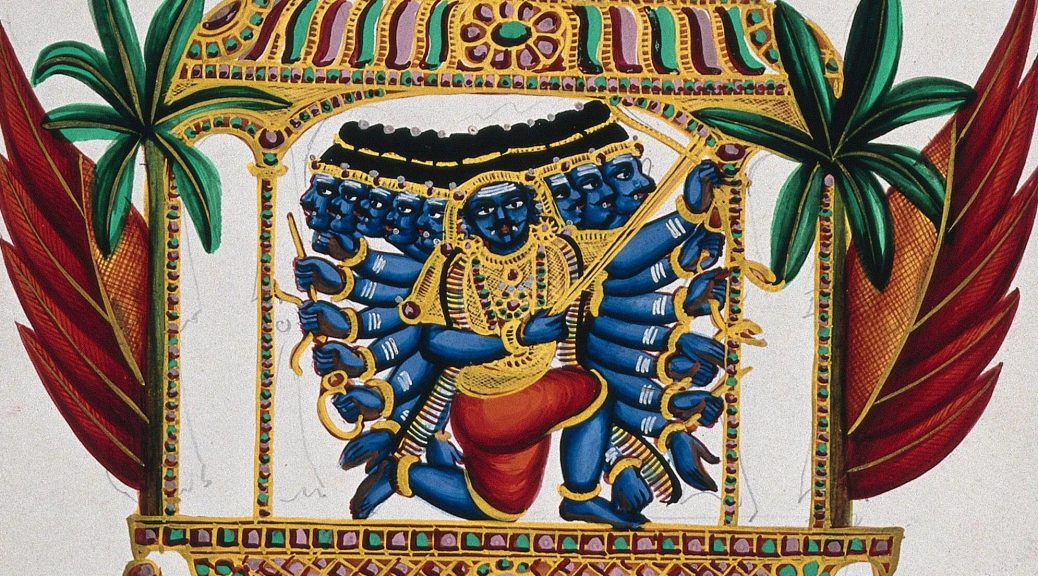Many think the Wright Brothers invented the first plane in 1903 but the truth is that demon-king Ravana was the first known person in the world to fly an aircraft around 7,000 years ago.
When explaining the purpose of research conducted based upon the ancient architecture that startles its audience to News18, Shashi Danatunge, ex-Vice Chairman, Civil Aviation Authority stated, “King Ravana was a genius. He was the first person to fly. He was an aviator. This is not mythology; it is a fact. There needs to be detailed research on this. In the next five years, we will prove this”.1
If Ravana was the world’s first aviator, the Ramayana also claims that Hanuman, the Hindu monkey-god, could fly without the use of a ‘pushpaka vimanam’ or a Ravana-style aircraft. This raises the question of whether The Vimana was a myth or a reality. According to Valmiki Ramayana, it describes Ravana riding “The great golden aerial chariot, Pushpaka”.2 Ravana had acquired aviation skills and built his own aerial vehicle. The Tourism Ministry has taken up the challenge of proving that aerial chariots were in fact a reality, as mentioned in Hindu mythology.
Ravana does have an aerial vehicle in the original Sanskrit version of the Ramayana in which he abducts Princess Sita, although there is no evidence of its mechanics or that it resembles a bird (or peacock) in design. Indeed, vimanas, or “flying castles,” are a common visual metaphor in Hindu, Buddhist, and Jain texts from South Asia, some of which date back more than 2000 years.
Martin Wickramasinghe wrote The Dandumonara Kathava, a little children’s book based on one of these famous folk stories. The peacock’s design is depicted in these stories: its wings flap to create lift, and the operator “peddling” (padinav) from his pilot seat controls pitch and direction with three ropes (tied to ailerons?). While the Sinhala term for this device (dandu-monara, or “wooden peacock”) is unique, the core story topic and the notion of the bird-machine can be found in numerous regional literature and oral traditions across India. The dandu-monara appears to be a representative of a wider literary genre in Sanskrit literature that deals with mechanical contraptions, including human and animal machines, which are found in the Pañcatantra (an old collection of folktales) and the Kathasaritsagara (“Ocean of the Streams of Stories”).
The Samarangana Sutradhara, a technical treatise written by the poet-king Bhoja (fl. 1025), includes a chapter on machines that blurs the lines between magical and technical in its descriptions of elaborate plumming, automatically refilling oil lamps, motorized menageries, robotic soldiers, and alchemically enabled combustion engines. There are several particular directions on how to build flying aircraft in the text:
laghudārumayam mahāvihaṅgaṃ dṛḍhasuśliṣṭatanuṃ vidhāya tasya udare rasayantramādadhīta jvalanādhāramadho’ sya cāti pūrṇam, Having built a great bird made of light wood, with a fine, tightly knit outer covering, and placing within its belly a mercury mechanism (rasa-yantram) functioning as a receptacle for a blazing fire,

tāruḍha puruṣastasya pakṣadvandvoccālaprojjhitena anilena
suptasvāntaḥ pāradasyāsya śaktyā citraṃ kurvannambare yāti dūram
Through the power of that mercury (pāradasya śaktyā) and the force of the air released from the wings [of the bird] flapping in unison, a man mounted atop it may travel a great distance through the sky, painting pictures [amid the clouds], his mind altogether serene.
–Bhoja’s Samarangana Sutradhara, chapter 31, verses 95 and 96 (Translation)
These Ancient Hindu inventions gave courage and assured that mankind could evolve and enhance technology to further aid the world and its people. The first-ever flying vehicle existed some 7000 years ago, it was called “The Vimana”, a couple of thousands of years later the Wright brothers invented the first plane. Some examples of recreated technologies in this day are; targeted missiles back in ancient India they were known as “Astra’s” and test-tube babies, the first test-tube babies were known to be Gandhari’s 100 sons, the Kauravas, and many more.
These technologies would, later on, be discussed further in the next articles. Hope to see you soon!
This article is part of a series titled “The Ancient Mysteries”
Feature image source
References:
– Henry, Justin. 2019. “Ravana’s Mechanical Flying Peacock.” Council of American Overseas Research Centers.
– Lakshmi, Rama. 2015. “Indians invented planes 7000 years ago — and other startling claims at the Science Congress.” The Washington Post.
https://www.washingtonpost.com/news/worldviews/wp/2015/01/04/indians-invented-pla nes-7000-years-ago-and-other-startling-claims-at-the-science-congress/.
– Moorthy, Saathiya. 2020. “Ravana the aviator, mythology or science? – South Asia Journal.” South Asia Journal.
http://southasiajournal.net/ravana-the-aviator-mythology-or-science/.
– Satish, DP. 2020. “Sri Lanka Says Enough Facts to Prove Ravana Was 1st to Use Aircraft, Asks People to Help With Research.” News18, July 19, 2020.
https://www.news18.com/news/world/sri-lanka-says-enough-facts-prove-ravana-used-aircr aft-to-fly-asks-people-to-help-with-in-depth-research-2723371.html
– “Sloka & Translation.” n.d. Sloka & Translation | Valmiki Ramayanam. Accessed February 6, 2022.
https://www.valmiki.iitk.ac.in/sloka?field_kanda_tid=1&language=dv&field_sarga_value= 3.
– “Sri Lankan government asks people to submit proof that Ravana used the first aircraft.” 2020. Deccan Herald. https://www.deccanherald.com/international/sri-lankan-government-asks-people-to-submi t-proof-that-ravana-used-the-first-aircraft-863219.html

